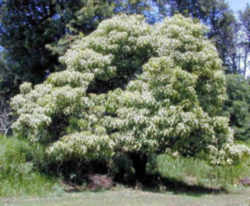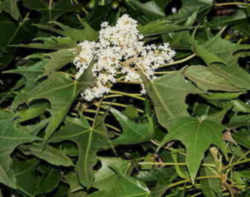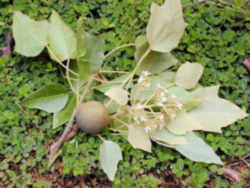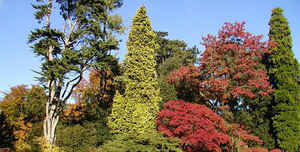
Hawaii Symbols
Hawaii State Tree
Kukui (candlenut tree)

(Aleurites Moluccana)
Adopted in 1959.
On March 17, 1930, Lawrence McCully Judd while serving as Territorial Governor of Hawai'i, issued a proclamation declaring the coconut palm or niu
(Cocos nucifera) to be the official tree of the Territory of Hawai'i.
The niu served as the official tree until April 30, 1959. On May 1, 1959, with Joint Resolution No. 3, the 30th Territorial Legislature of Hawai'i
approved the kukui, or candlenut tree, (Aleurites moluccana), as the official tree of the State of Hawai'i.
Hawaii State Tree: Kukui (candlenut tree)

A Polynesian introduced plant species. the kukui, (Aleurites moluccana,) better known as the candlenut. The nuts of this tree provided the ancient Hawaiians with light, oil, relishes, and medicine. It was adopted in 1959.
Medium-sized tree, up to 20 m tall, ornamental, with widespreading or pendulous branches; leaves simple, variable in shape, young leaves large, up to 30 cm long, palmate, with 3--7 acuminate lobes, shining, while leaves on mature trees are ovate, entire, and acuminate, long-petioled, whitish above when young, becoming green with age, with rusty stellate pubescence beneath when young, and perisiting on veins and petiole; flowers in rusty-pubescent panicled cymes 10--15 cm long; petals 5, dingy white or creamy, oblong, up to 1.3 cm long; ovary 2-celled; fruit an indehiscent drupe, roundish, 5 cm or more in diameter, with thick rough hard shell making up 64--68% of fruit, difficult to separate from kernels; containing 1 or 2 seeds. Fl. Apr.--May (Sri Lanka).
Charactristics of Hawaii Kukui (candlenut tree)

Distribution
Native to Malaysia, Polynesia, Malay Peninsula, Philippines and South Seas Islands; now widely distributed in tropics. Naturalized or cultivated in Malagasy, Sri Lanka, southern India, Bangladesh, Brazil, West Indies, and Gulf Coast of United States
Uses
Seed yields 57--80% of inedible, semi-drying oil, liquid at ordinary temperatures, solidifying at -15°C, containing oleostearic acid. Oil, quicker drying than linseed oil, is used as a wood preservative, for varnishes and paint oil, as an illuminant, for soap making, waterproofing paper, rubber substitutes and insulating material. Seeds are moderately poisonous and press cake is used as fertilizer. Kernels when roasted and cooked are considered edible; may be strung as candlenuts. Oil is painted on bottoms of small crafts to protect against marine borers. Tung oil, applied to cotton bolls, stops boil weevils from eating them. Also prevents feeding by striped cucumber beetle.
Folk Medicine
Bark used on tumors in Japan. The oil is purgative and sometimes used like castor oil. Kernels are laxative stimulant, and sudorific. The irritant oil is rubbed on scalp as a hair stimulant. In Sumatra, pounded seeds, burned with charcoal,are applied around the navel forcositiveness. In Malaya, the pulped kernel enters poultices for headache, fevers, ulcers, and swollen joints. In Java, the bark is used for bloody diarrhea or dysentery. Bark juice with coconut milk is used for sprue. Malayans apply boiled leaves to the temples for headache and to the pubes for gonnorhea
Territorial Legislature of Hawai'i Joint Resolution No. 3
Joint Resolution No. 3, the 30th Territorial Legislature of Hawai'i approved the kukui, or candlenut tree (Aleurites moluccana),
as the official tree of the State of Hawai'i.
Joint Resolution No. 3 read, in part,
"WHEREAS, the kukui tree is a tree native to all the islands of Hawai'i and
"WHEREAS, the multiplicity of its uses to the ancient Hawai'ians for light, fuel, medicine, dye and ornament and its continued value to the people
of modern Hawaii, as well as the distinctive beauty of its light green foliage which embellishes many of the slopes of our beloved mountains, causes
the kukui tree to be especially treasured by the people of the Fiftieth State of the United States as an arboreal symbol of Hawai'i. . ."
Hawai`i Law
The law designating the kukui tree as the official Hawaii state tree is found in the Hawai`i Revised Statutes, Volume 1, Chapter 5, Section 5.8.
Volume 1.
CHAPTER 5. EMBLEMS AND SYMBOLS.
SECTION 5.8.
§5-8 State tree. The kukui tree, also known as the candlenut tree (Aleurites moluccana), is adopted, established, and designated as the official
tree of the State, to be effective so long as the legislature of the State does not otherwise provide.
[L 1959, JR 3, §1; Supp, §14-5.2; HRS §5-8]
Taxonomic Hierarchy: Kukui Tee (Candlenut Tree)
Kingdom: Plantae - Plants
Subkingdom: Tracheobionta - Vascular plants
Superdivision: Spermatophyta - Seed plants
Division: Magnoliophyta - Flowering plants
Class: Magnoliopsida - Dicotyledons
Subclass: Rosidae
Order: Euphorbiales
Family: Euphorbiaceae - Spurge family
Genus: Aleurites J.R. Forst. & G. Forst. - aleurites
Species: Aleurites moluccanus (L.) Willd. - Indian walnut







